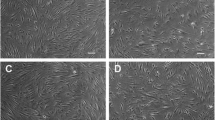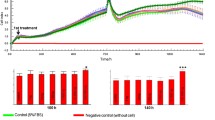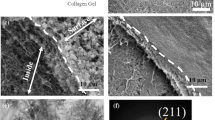Abstract
Ameloblastin (Ambn, also named “amelin” or “sheathlin”) is a protein participating in enamel formation and mesenchymal-ectodermal interaction during early dentin formation in developing teeth. Experiments have demonstrated an association between Ambn expression and healing of acute pulp wounds. The purpose of this study was to investigate if local application of recombinant fusion Ambn (rAmbn) could influence reparative dentin formation in pulpotomized teeth. In this randomized, double-blinded study, pulpotomy was performed in 28 lower central incisors in 17 adult miniature pigs. Following the surgical procedure, the exposed pulp tissue was covered either with rAmbn or with calcium hydroxide. After 2, 4, or 8 weeks, the teeth were extracted and examined by histomorphometry and immunohistochemistry using antibodies against porcine ameloblastin, collagen type I, and dentin sialoprotein (DSP). In rAmbn-treated teeth, a substantial amount of newly formed reparative dentin was observed at the application site, completely bridging the pulpal wound. Dentin formation was also observed in calcium hydroxide-treated teeth; however, the amount of reparative dentin was significantly smaller (P < 0.001) than after rAmbn treatment. Immunohistochemistry confirmed that the new hard tissue formed was similar to dentin. This is the first time a direct link between ameloblastin and dentin formation has been made in vivo. The results suggest potential for rAmbn as a biologically active pulp-dressing agent for enhanced pulpal wound healing and reparative dentin formation after pulpotomy procedures.



Similar content being viewed by others
References
Yamamura T (1985) Differentiation of pulpal cells and inductive influences of various matrices with reference to pulpal wound healing. J Dent Res 64:530–540
Ranly DM (1994) Pulpotomy therapy in primary teeth: new modalities for old rationales. Pediatr Dent 16:403–409
Ranly DM, Garcia-Godoy F (2000) Current and potential pulp therapies for primary and young permanent teeth. J Dent 28:153–161
Tziafas D, Smith AJ, Lesot H (2000) Designing new treatment strategies in vital pulp therapy. J Dent 28:77–92
Nakashima M (1994) Induction of dentin formation on canine amputated pulp by recombinant human bone morphogenetic proteins (BMP)-2 and -4. J Dent Res 73:1515–1522
Rutherford RB, Wahle J, Tucker M, Rueger D, Charette M (1993) Induction of reparative dentin formation in monkeys by recombinant human osteogenic protein-1. Arch Oral Biol 38:571–576
Nakashima M (1989) Dentin induction by implants of autolyzed antigen-extracted allogeneic dentin on amputated pulps of dogs. Endod Dent Traumatol 5:279–286
Termine JD, Belcourt AB, Christner PJ, Conn KM, Nylen MU (1980) Properties of dissociatively extracted fetal tooth matrix proteins. I. Principal molecular species in developing bovine enamel. J Biol Chem 255:9760–9768
Nakamura Y, Hammarström L, Lundberg E, Ekdahl h, matsumoto k, Gestrelius S, Lyngstadaas SP (2001) Enamel matrix derivative promotes reparative processes in the dental pulp. Adv Dent Res 15:105–107
Nakamura Y, Hammarström L, matsumoto k, Lyngstadaas SP (2002) The induction of reparative dentin by enamel proteins. Int Endod J 35:407–417
Nakamura Y, Slaby I, Matsumoto K, Richie HH, Lyngstadaas SP (2004) Immunohistochemical characterization of rapid dentin formation induced by enamel matrix derivative. Calcif Tissue Int 75:243–252
Cerny R, Slaby I, Hammarström L, Wurtz T (1996) A novel gene expressed in rat ameloblasts codes for proteins with cell binding domains. J Bone Miner Res 11:883–891
Krebsbach PH, Lee SK, Matsuki Y, Kozak CA, Yamada KM, Yamada Y (1996) Full-length sequence, localization, and chromosomal mapping of ameloblastin. A novel tooth-specific gene. J Biol Chem 271:4431–4435
Hu CC, Fukae M, Uchida T, Qian Q, Zhang CH, Ryu OH, Tanabe T, Yamakoshi Y, Murakami C, Dohi N, Shimizu M, Simmer JP (1997) Sheathlin: cloning, cDNA/polypeptide sequences, and immunolocalization of porcine enamel sheath proteins. J Dent Res 76:648–657
MacDougall M, Simmons D, Gu TT, Forsman-Semb K, Mardh CK, Mesbah M, Forest N, Krebsbach PH, Yamada Y, Berdal A (2000) Cloning, characterization and immunolocalization of human ameloblastin. Eur J Oral Sci 108:303–310
Uchida T, Murakami C, Wakida K, Dohi N, Iwai Y, Simmer JP, Fukae M, Satoda T, Takahashi O (1998) Sheath proteins: synthesis, secretion, degradation and fate in forming enamel. Eur J Oral Sci 106(suppl 1):308–314
Fong CD, Slaby I, Hammarström L (1996) Amelin: an enamel-related protein, transcribed in the cells of epithelial root sheath. J Bone Miner Res 11:892–898
Fong CD, Cerny R, Hammarstöm L, Slaby I (1998) Sequential expression of amelin gene in mesenchymal and epithelial cells during odontogenesis in rats. Eur J Oral Sci 106(Suppl 1):324–330
Spahr A, Lyngstadaas SP, Slaby I, Haller B, Boeckh C, Tsoulfidou F, Hammarstrom L (2002) Expression of amelin and trauma-induced dentin formation. Clin Oral Investig 6:51–57
Ritchie H, Wang L-H (1998) The expression of DSP protein from a baculovirus construct containing rat DSP-PP cDNA. J Dent Res 77:157
Van Ittersum J, Ritchie H (2002) Post-translational analysis of rat dentin phosphophoryn from dentin matrix and a DSP-PP construct. J Dent Res 81:A278
Hsu SM, Raine L, Fanger H (1981) Use of avidin-biotin-peroxidase complex (ABC) in immunoperoxidase techniques: a comparison between ABC and unlabeled antibody (PAP) procedures. J Histochem Cytochem 29:577–580
Butler WT (1995) Dentin matrix proteins and dentinogenesis. Connect Tissue Res 33:59–65
Acknowledgments
The DSP antibody was a kind gift from Dr. H. H. Ritchie. We also thank E. Lundberg, H. Ekdahl, and U.-B. Carlsson for excellent assistance during the animal procedures and B. Fabi for kind help with photographs and figures. The work was sponsored by EU grant QLK3-CT-2001-00090 MATRIX and Japan Society for Promotion of Science (JSPS) grant in scientific research (C) 16591921.
Author information
Authors and Affiliations
Corresponding author
Rights and permissions
About this article
Cite this article
Nakamura, Y., Slaby, I., Spahr, A. et al. Ameloblastin Fusion Protein Enhances Pulpal Healing and Dentin Formation in Porcine Teeth. Calcif Tissue Int 78, 278–284 (2006). https://doi.org/10.1007/s00223-005-0144-2
Received:
Accepted:
Published:
Issue Date:
DOI: https://doi.org/10.1007/s00223-005-0144-2




